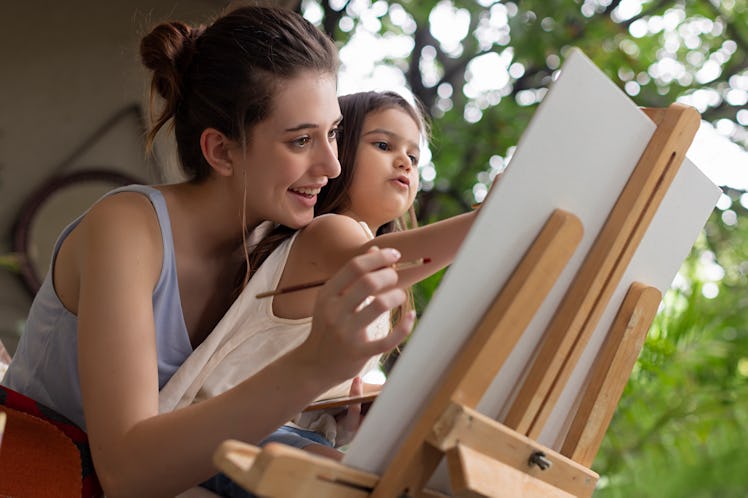How To Raise A Creative Kid (But Not A Daydreaming Weirdo)
The goal for parents shouldn’t just be creating spaces for free thinking, but defining those spaces. Give the kids the heavens, sure, but tether them to Earth.

Imagination is an asset. When it’s properly nourished, imagination helps kids solve problems, entertain themselves, and turn playground trips into adventures. But investing in imagination can expose parents and children to risk: It’s not uncommon for imaginative children to struggle with deadlines, organization, and responsibility. So the goal for parents shouldn’t just be creating spaces for free thinking, but defining those spaces. Give the kids the heavens, sure, but tether them to Earth.
Alan Kazdin, Ph.D., a renowned professor of psychology and child psychiatry and head of the Yale Parenting Center, has spent years developing methods for encouraging creative play and discouraging inattention. “Play and imagination, playing pretend, playing with voices — at a certain age, that’s a very normal part of development,” Kazdin explains. “It’s critical for kid’s development.”
When and How Should Parents Model Imagination for Kids?
According to Kazdin, there’s no “right” age to start modeling imagination and creative play. He insists that new parents discuss what traits they want to foster in their child and begin modeling associated behaviors as soon as is feasibly possible. And, yes, that might mean playing make-believe with a baby.
Yes, Kazdin says, some children are more naturally imaginative than others. But that doesn’t mean kids are unable to be taught. “It makes a difference that Picasso’s father was an artist,” he says. “But we can do a lot with environment, without the genes.”
Say it’s time for an art project and you’ve provided your kids with paints or colored pencils. Give your kids instructions to draw a sun. Then, excitedly say, “Let’s draw a weird-looking sun with clouds that block it!” or whatever you think is fun and creative. After some time has passed, say, “Let’s share our drawings at the same time!” When that happens, emphasize the originality of the child’s vision. Say, “Look at your sun! Your sun has black and green, unlike the sun in the sky, which is orange and yellow. That’s really great that you’re using your imagination!” By encouraging the kid not be literal, you’re giving the kid a space in which to be creative.
Three Tips for Modeling Imagination
Modeling imagination doesn’t mean parents need to throw away their office jobs and start a career in oil painting. It can be taught in simple, small ways, largely through engaging in creative play. Here are some of Kazdin’s recommendations.
Scatter the Playroom With Creative Toys
“Bring in things that are novel, and leave them around for the child to tinker with,” says Kazdin. For example, the Little Bits Music Inventor Kit is a toy through which kids can assemble components and make different musical instruments. But there is, of course, nothing wrong with classic wooden blocks.
Remember that you can’t just leave imagination-generating toys on the ground and walk away. You need to actively play with, and respond to, your kid. Parenting an imaginative kid means getting on the ground with them and pretending you’re dinosaurs who survived the comet and were thrown to a planet far, far away.
Get Weird With It
Modeling imagination requires that parents encourage their kids to be imaginative by asking children to flex creative muscles. “If you’re building something out of a plastic toy set, you might make a building out of it,” says Kazdin. “But you also might ask your kid, ‘What is the strangest building we can possibly make? What would it look like?’” Kadzin says. She stresses, however, to not use such words as ‘Don’t,’ or ‘That’s not right,’ or ‘This isn’t good.’” The process should be fun and parents should encourage it.
Prevent Kids From “Self-Screening”
Per Kazdin, it’s important that parents encourage kids’ questions, no matter how ludicrous or funny they may seem. “We never want a child to ever think that there’s a dumb question,” says Kazdin. “Letting a child think there is a dumb question means they’re already learning to self-screen, when in fact, being creative and imaginative is about opening up and not self-screening.”
How to Avoid Having Imagination Lead to Disengagement
Although imagination is deeply important for kids as a problem-solving tool and engine of play, parents still need to help their kids understand that completing tasks, following rules, and adhering to deadlines are incredibly important standards in education and in life. That means that, while you need to reward and encourage creativity, it’s important to set boundaries.
“The main lesson in life hasn’t changed,” says Kazdin. “That lesson is in moderation.” Kazdin emphasizes the little kids need to know when it’s time for creative play and when it’s the time to complete tasks that help them succeed in school and in daily life. They’re not going to guess right the first time. Parents need to tell them and remind them.
“Parents have strong ideas about how to raise their children,” says Kazdin. “But in the process, parents need to recognize that a kid needs imagination and that same kid also needs to be able to complete their homework. Homework is not the time to play.”
This article was originally published on